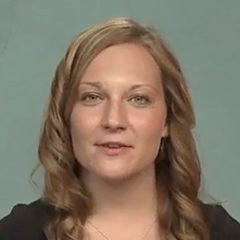
No More Tangled Thread
Leah RybakOne of the biggest annoyances of hand sewing is getting thread all tangled up. Leah Rybak gives us a helpful tip to help prevent this problem. Using beeswax helps the thread from sticking together and makes hand sewing a much more enjoyable experience.
Sometimes when you're hand sewing, one of the biggest annoyances can be getting all of your thread, all tangled up. A great tip for that is to run bees wax along the length of your thread. So that way it kind of separates the thread and it won't stick together or tangle as easily. We will show you how to do this really quick. What I'm gonna do is I'm gonna thread my needle.
Another tip I have for you is just to lick your needle instead of licking the end of your thread. And that way the thread is just drawn to that and the excess amount of thread for the tip, doesn't expand with your saliva. And that way you can hook this right here. We'll tie it. If I can get it, here we go.
Oh, not quite. Tie that on and we'll take this bees wax and we'll just kinda pull, hold it down hard against the table. And we'll just kind of pull our thread through there, so it finely coats the thread. I know it's kind of hard to see but you can feel it on the thread. And this way, once you get a pile of thread together, it'll kind of hold itself on its own and won't stick and won't get all jumbled together.
As you can see, it just happened kind of right there as we were pulling this. And we're almost done, get to the end here almost. And set that bees wax down, that way you can start any projects. Leave your excess thread there and we'll just hand sew like we would normally. This is a great tip for keeping that thread separated for your any hand sewing project.

To help keep hand sewing thread from tangling put the knot in the end that comes off the spool last. Thread has a knap or direction. Gently pull a piece of thread (it can be hand sewing thread, sewing machine thread, embroidery floss, yarn or even string) through thumb and forefinger one way then the other. You will notice that one direction is smoother than the other. Put the knot at the end of the smoother direction. The is the end that comes off the spool last.
What happened to the conditioner to apply to the spool?
No need to post this feedback. Moderator: please teach instructors to speak proper English. "show you this quick?" ...quickly. "kina?" kind of. Also, not every sentence should end as a sentence. Hair flipping and low cut shirt is distracting and annoying to us seniors.
That knot...I've never heard of that idea before! It won't cause trouble when you start sewing? And I've also wondered if the residue of the beeswax will show when the fabric is ironed later?
Why was she knotting the thread at the needle?
Do you run the needle & thread through the beeswax or lay the bees wax on top of the thread and pull it... You could not tell from the picture. Enjoy the videos.
what's with the to low plunging neckline????? PLEASE
This only works if you iron the thread after running it through the wax to set it into the thread otherwise as soon as you start sewing the wax rubs off in the material after the first few passes.
Suggestion: A long-standing rule in both hand sewing and hand embroidery is to limit the thread's length to 18". I have found that if I try to go much over this amount I always have trouble, even with beeswax.